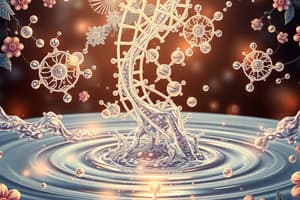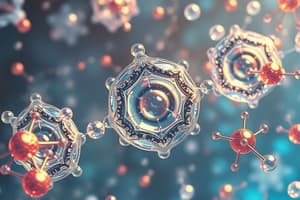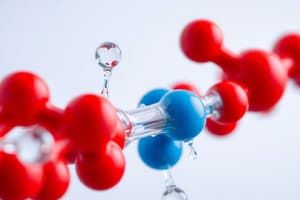Podcast
Questions and Answers
As the hamster eats the pizza it is taking in energy that is:
As the hamster eats the pizza it is taking in energy that is:
- High entropy (correct)
- Low entropy
After the hamster finishes eating it runs on its wheel. The energy it consumed is transformed with the waste energy being lost as _____ energy:
After the hamster finishes eating it runs on its wheel. The energy it consumed is transformed with the waste energy being lost as _____ energy:
heat
Which of the following describes the smallest unit of an element?
Which of the following describes the smallest unit of an element?
- Neutron
- Atom (correct)
- Proton
- Molecule
What is another term for the atomic number?
What is another term for the atomic number?
What is the shorthand for the element carbon?
What is the shorthand for the element carbon?
What is another term for 'protons + neutrons'?
What is another term for 'protons + neutrons'?
Isotopes have a different number of protons?
Isotopes have a different number of protons?
Atoms are more stable when their ______ is 0.
Atoms are more stable when their ______ is 0.
What must happen to electrons to get valence to 0?
What must happen to electrons to get valence to 0?
What is another term for how strongly a nucleus pulls in electrons?
What is another term for how strongly a nucleus pulls in electrons?
If electronegativity is similar electrons will be shared.
If electronegativity is similar electrons will be shared.
Sharing forms a ______ _______ that holds them together.
Sharing forms a ______ _______ that holds them together.
A molecule is any number of covalently bound atoms.
A molecule is any number of covalently bound atoms.
Same or very similar electronegativity gives a polar bond
Same or very similar electronegativity gives a polar bond
If the difference is large, electrons are pulled more towards one ______.
If the difference is large, electrons are pulled more towards one ______.
If an atom gains an electron, what is the charge called?
If an atom gains an electron, what is the charge called?
Which bond is the strongest?
Which bond is the strongest?
Water is non-polar.
Water is non-polar.
What is another term for 'water-loving'?
What is another term for 'water-loving'?
Water usually breaks ionic bonds but NOT covalent bonds.
Water usually breaks ionic bonds but NOT covalent bonds.
Nonpolar compounds are ____.
Nonpolar compounds are ____.
Lower pH _______ H+.
Lower pH _______ H+.
Which element is MOST LIKELY to form polar bonds?
Which element is MOST LIKELY to form polar bonds?
What kind of substance would be least likely to dissolve in water?
What kind of substance would be least likely to dissolve in water?
What part of the molecule is most likely to be attracted to water?
What part of the molecule is most likely to be attracted to water?
Flashcards
Elements
Elements
Pure substances that cannot be broken down further and have the same properties.
Atom
Atom
The smallest unit of an element, composed of protons, neutrons, and electrons.
Atomic Number
Atomic Number
Number of protons in an atom.
Atomic Symbol
Atomic Symbol
Signup and view all the flashcards
Mass Number
Mass Number
Signup and view all the flashcards
Isotopes
Isotopes
Signup and view all the flashcards
Valence Shell
Valence Shell
Signup and view all the flashcards
Valence Electrons
Valence Electrons
Signup and view all the flashcards
Electronegativity
Electronegativity
Signup and view all the flashcards
Covalent Bond
Covalent Bond
Signup and view all the flashcards
Molecule
Molecule
Signup and view all the flashcards
Nonpolar Bond
Nonpolar Bond
Signup and view all the flashcards
Polar Bond
Polar Bond
Signup and view all the flashcards
Partial Charge
Partial Charge
Signup and view all the flashcards
Hydrogen Bond
Hydrogen Bond
Signup and view all the flashcards
Ionic Bond
Ionic Bond
Signup and view all the flashcards
Anion
Anion
Signup and view all the flashcards
Cation
Cation
Signup and view all the flashcards
Hydrophilic
Hydrophilic
Signup and view all the flashcards
Hydrophobic
Hydrophobic
Signup and view all the flashcards
pH
pH
Signup and view all the flashcards
Acid
Acid
Signup and view all the flashcards
Base
Base
Signup and view all the flashcards
Carbon
Carbon
Signup and view all the flashcards
Functional Groups
Functional Groups
Signup and view all the flashcards
Hydroxyl Group
Hydroxyl Group
Signup and view all the flashcards
Amino Group
Amino Group
Signup and view all the flashcards
Carboxyl Group
Carboxyl Group
Signup and view all the flashcards
Amphipathic
Amphipathic
Signup and view all the flashcards
Van der Waals interactions
Van der Waals interactions
Signup and view all the flashcards
Study Notes
- Fundamental chemistry concepts covered are the properties of water and organic molecules
- The class for Spring 2025 is taught by Dr. Maximilian Lyon
- The class is scheduled for MWF from 12:00-12:50 pm in ISE 211
Housekeeping
- Office hours are Thursday, 11 am - 12 pm with Betsy in Ritter 314
- Office Hours are Friday, 10 am - 11 am with Lyon in Macelwane 100
- Office Hours are Sunday, 5 pm - 6 pm with Katie in Ritter 323
- Attendance/participation will start being tracked next week
- There is assistance available for those with Achieve access issues
iClicker Setup
- The course name is BIOL 1260-05 Maximilian Lyon
- The iClicker can be joined at https://join.iclicker.com/ASPD
- Only use your SLU email for iClicker
- Start iClicker at the beginning of each class
- A laptop/phone/tablet can be used for iClicker
- If there are connection issues, use a different device or follow the trouble shooting tips https://mhe.my.site.com/iclicker/s/article/Attendance-Geolocation-Tips
Learning Objectives
- Describe and differentiate covalent, ionic, and hydrogen bonds
- Based on relative electronegativity of atoms, determine if a covalent bond is polar or nonpolar
- For polar covalent bonds, identify which atom carries partial positive, and which carries partial negative charge
- Explain why chemical functional groups or molecules are either hydrophilic (water-soluble) or hydrophobic (insoluble in water)
- Predict whether molecules or chemical groups, in water, release or gain protons, and impact on pH
Elements and Atoms
- Elements are pure substances that cannot be further broken down and have the same properties
- The smallest unit of an element is an atom, composed of different amounts of 3 particles
- Protons have a +1 charge and neutrons are in the nucleus, combined they define mass
- Electrons orbit in clouds, and have a -1 charge
Defining Elements
- Atomic number is the number of protons
- Atomic symbol is a shorthand for the element (C for carbon)
- Mass number is the number of protons plus neutrons
- Isotopes have a different number of neutrons and a different mass
- Elements can have different numbers of neutrons, but must have the same number of protons
Electron Arrangement
- Electrons are arranged in shells
- The first shell holds up to 2 electrons; later shells hold up to 8
- Lowest energy shells must be full before another one can be added
Valence Electrons
- The outermost shell contains the valence electrons
- Valence electrons can interact with other atoms
Electronegativity
- Atoms are more stable when their valence is 0
- To achieve a valence of 0, electrons must be transferred or shared
- Electronegativity is how strongly a nucleus pulls in electrons
- More electronegative atoms are more likely to take electrons
- Oxygen (O) has an electronegativity of 3.4
- Chlorine (Cl) has an electronegativity of 3.2
- Nitrogen (N) has an electronegativity of 3.0
- Carbon (C) has an electronegativity of 2.6
- Phosphorus (P) has an electronegativity of 2.2
- Hydrogen (H) has an electronegativity of 2.2
- Sodium (Na) has an electronegativity of 0.9
- Potassium (K) has an electronegativity of 0.8
Equal Sharing: Covalent Bonds
- When electronegativity is similar, electrons are shared
- Sharing forms a covalent bond that holds atoms together
- A molecule is any number of covalently bound atoms
- Same or very similar electronegativity results in a nonpolar bond
Unequal Sharing
- If the difference is large, electrons are pulled more towards one nucleus
- This leaves a partial (δ) + or - charge on both atoms
- More electronegative atoms become δ-, less electronegative atoms become δ+
- These partial charges can attract. If H is involved, form hydrogen bonds between molecules
Ionization and Ionic Bonds
- Extreme electronegativity differences result in electron transfer, then both atoms become ions
- The atom that gains electrons becomes a negatively charged anion
- The atom that loses electrons becomes a positively charged cation
- Positive and negative charges attract and forming an ionic bond
Ranking of Bond Strength
- Covalent bonds involve electrons shared in orbitals, and require between 200-500 kJ/mole to break single bonds, and 500-700 kJ/mole to break double bonds
- Ionic bonds involve electrons transferred with electrostatic reaction between oppositely charged ions, and require between 1,100-20,000 kJ/mole to break within ionic crystal
- Hydrogen bonds involve electrostatic attraction between slightly positively charged H and slightly negatively charged O and N atoms, and require between 4-50 kJ/mole to break
- van der Waals interactions involve transient electrostatic attraction between two atoms, each in a nonpolar covalent bond, and require less than 4 kJ/mole to break
Representations of Biomolecules
- Molecular formulas list the types and number of atoms present (e.g. NH2CH2COOH)
- Structural formulas show what is bound to what
- Ball-and-stick models show 3D relationship between atoms
- Space-filling models show relative sizes, most accurate
Water: Polarity and Hydrogen Bonding
- Water molecules are polar, the oxygen atom is partially negative (-), and hydrogen atoms are partially positive (+)
- Hydrogen bonds are weak attractions between partially positive hydrogens and partially negative atoms (usually O or N) in other molecules
- Solid lines represent covalent bonds and dotted lines represent hydrogen bonds
Water as a Solvent
- Life is based on water
- Most molecules in cells are water
- Water is an excellent solvent
- Water dissolves most polar and ionic molecules
Hydrophilic and Hydrophobic Molecules
- Many important biomolecules are soluble in water
- Hydrophilic/water-loving molecules dissolve in water
- Water usually breaks ionic bonds but not covalent bonds
- Nonpolar compounds are hydrophobic/water fearing and do not dissolve in water
- Hydrophobic molecules have few if any full or partial charges
- Large non-polar molecules can be held together by extremely weak van der Walls interactions
pH
- Covalent bonds of water molecules can spontaneously break
- pH = concentration of free H+ ions
- pH = -log[H+]
- High pH means less H+
The pH Scale
- Water is constantly breaking and reforming
- Pure water at room temperature has 10⁻⁷ moles/L of H⁺ and OH⁻
- pH 7 is considered neutral and a reference for other solutions
- Lower pH is acidic and releases H⁺ (H⁺ donor)
- High pH is basic and accepts H⁺ (H⁺ acceptor)
- Strong acids/bases always give/take H⁺
Carbon and Functional Groups
- Carbon is the basis for organic molecules
- A cell is mostly water; functional groups dictate how molecules interact with water (and each other)
- Functional groups: Methyl, Carbonyl, Hydroxyl, Sulfhydryl, Amino, Phosphate, Carboxyl
- R represents the rest of the molecule
- Aq means dissolved in water
Ionizing Groups
- Amino groups, in water, attract a H⁺ ion (proton) and become positively charged (base)
- Carboxyl groups, in water, release a proton and becomes negatively charged (acid)
- Phosphate groups, in water, releases 2 protons and winds up with 2 negatively charged O (acid)
Reminders
- Complete the reading quiz by Wednesday at 12:00 pm
- Read Chapters 3.1, 4.1, and 4.4
- Find course highlights at https://macmillan.vitalsource.com/home/subscribe/maximilian.lyon%40slu.edu
Studying That Suits You
Use AI to generate personalized quizzes and flashcards to suit your learning preferences.




